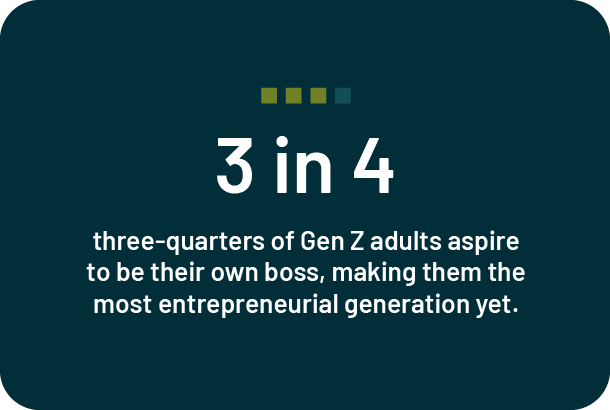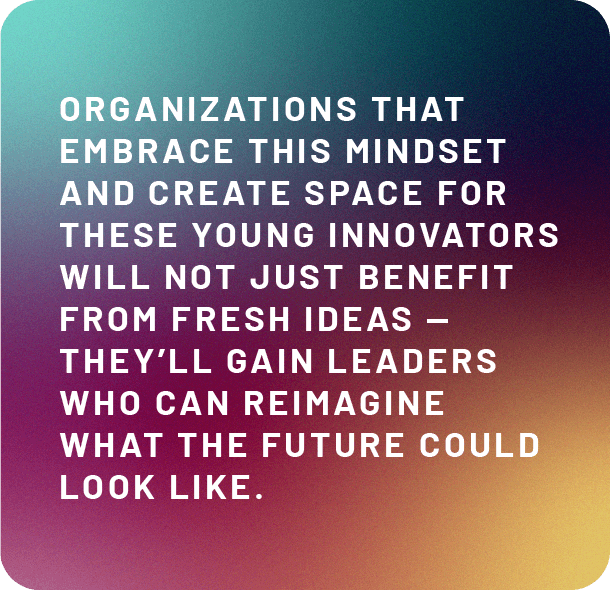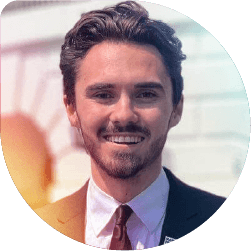
The New Generation of Innovators: Continuing to Ask “Why?”
February 13, 2025
Britney Cole
The Born Digital generations grew up in a world where long-held assumptions are constantly challenged by rapid technological and cultural change. For them, there are no sacred cows. So, they don’t just follow the rules—they ask why those rules exist in the first place.
This curiosity and willingness to challenge the status quo isn’t necessarily about rebellion—it’s about finding better answers, especially in cases where the status quo has failed to consider diverse perspectives and needs. They’re unafraid to push back on “we’ve always done it this way” thinking and dig deeper to uncover what really matters.
One of their greatest strengths is their ability to focus on defining the problem, not just solutions. They start by asking: “What are the actual problems we’re trying to solve? Who does it impact?” While understanding that innovation is about uncovering the root of a challenge in order to address it.

THE TALENT DILEMMA: WHY ARE YOUNG INNOVATORS LEAVING?

GAME-CHANGERS IN ACTION: STORIES THAT DEFINE A GENERATION
FROM BEES TO BOARDROOMS: LEIGH-KATHRYN BONNER AND BEE DOWNTOWN
 Leigh-Kathryn Bonner didn’t set out to simply “save the bees.” She saw a bigger picture—one that most people were missing. The common assumption was that pollinator decline was an ecological issue, something for scientists or nonprofits to solve. But Bonner asked a better question: “Why is this problem still persisting? Who else can help solve it, and how do we bring them in?”
Leigh-Kathryn Bonner didn’t set out to simply “save the bees.” She saw a bigger picture—one that most people were missing. The common assumption was that pollinator decline was an ecological issue, something for scientists or nonprofits to solve. But Bonner asked a better question: “Why is this problem still persisting? Who else can help solve it, and how do we bring them in?”
THE PROBLEM: but it’s also a business and community challenge as well. Pollinators are responsible for nearly 75% of the crops we eat. Their decline threatens ecosystems and disrupts agriculture, economies, and the communities that depend on them.
THE SOLUTION: Bonner redefined the challenge by turning pollinator preservation into a corporate opportunity. Through Bee Downtown, she partners with companies to install and maintain honeybee hives on their campuses. But this is about more than hosting bees—it’s transforming sustainability into something tangible, participatory, and impactful. The hives are tools for team-building, leadership development, and engagement.
THE IMPACT: Bee Downtown has turned corporate campuses into hubs of connection and purpose. Companies like Delta and Burt’s Bees use the hives to support pollinator populations and, more importantly, to foster collaboration and growth among their teams. Employees leave hive tours and workshops inspired by the bees’ lessons—on adaptability, teamwork, and shared purpose. Bonner’s vision shows us that we can help solve environmental challenges by creating stronger, more connected communities at work.
THE CORPORATE INFLUENCER: LARA SOPHIE BOTHUR AT DELOITTE
 Lara Sophie Bothur is rewriting the playbook on how large organizations connect with younger audiences. As a Gen Z strategist at Deloitte, she’s pioneering the role of the “corporate influencer.” Bothur has built a significant following by aligning her personal brand with Deloitte’s mission to solve complex business challenges.
Lara Sophie Bothur is rewriting the playbook on how large organizations connect with younger audiences. As a Gen Z strategist at Deloitte, she’s pioneering the role of the “corporate influencer.” Bothur has built a significant following by aligning her personal brand with Deloitte’s mission to solve complex business challenges.
THE PROBLEM: For traditional organizations like Deloitte, connecting with a digital-first generation in an authentic way has always been difficult. How do you earn the trust and attention of a generation that values transparency and innovation above all else?
THE SOLUTION: Bothur bridged the gap by leveraging social media to break down complex ideas, showcase innovative projects, and humanize the corporate world. Her personal brand isn’t separate from Deloitte’s—it amplifies it. By turning herself into a trusted voice for her generation, she’s made Deloitte’s mission more relatable to young talent and clients alike.
THE IMPACT: Bothur’s work demonstrates the power of authenticity and individual influence within a corporate ecosystem. She’s shown that when companies empower young leaders to share their perspectives, they create stronger connections with the digital-first generation—and build trust for the future.
SUSTAINABILITY MEETS SOCIAL MEDIA: DAVID HOGG AND THE MARCH FOR OUR LIVES MOVEMENT
 David Hogg is a Gen Z leader redefining what it means to innovate in the social impact space. After the 2018 Parkland school shooting, Hogg turned personal tragedy into a platform for change, leveraging technology and storytelling to amplify his message.
David Hogg is a Gen Z leader redefining what it means to innovate in the social impact space. After the 2018 Parkland school shooting, Hogg turned personal tragedy into a platform for change, leveraging technology and storytelling to amplify his message.
THE PROBLEM: Gun violence in the U.S. is one of the most polarizing issues of our time. Hogg and his peers faced an uphill battle: breaking through entrenched viewpoints, apathy, and systemic resistance to reform.
THE SOLUTION: Hogg and the March for Our Lives team harnessed the power of digital activism. Viral social media campaigns and innovative fundraising models turned their movement into a force for action. They did more than inspire young people to vote—they empowered them to take a seat at the table, participate in town halls, and demand change.
THE IMPACT: March for Our Lives has become one of the most prominent youth-led movements in history, inspiring dialogue and legislation while proving that innovation doesn’t just belong in corporate boardrooms. It thrives in grassroots movements that bring urgency and purpose to solving society’s greatest challenges.
HOW CAN ORGANIZATIONS SUPPORT AND ATTRACT THESE INNOVATORS?

To foster this problem-focused approach and attract these emerging leaders, organizations need to first create environments where curiosity and questioning are celebrated as drivers of progress.
But fostering innovation isn’t about giving free rein and hoping for the best. Britney Cole, Chief Innovation Officer at Blanchard and Co-Founder of Bolster Leadership, talks about the role that leaders play in balancing freedom with structure to set young innovators up for success:
HOW CAN ORGANIZATIONS SUPPORT AND ATTRACT THESE INNOVATORS?
Here’s how we can create workplaces where they feel encouraged to be their natural innovative selves:
- Create Safety for Risk and Failure: Innovation thrives when people feel safe to experiment. Millennials and Gen Z want to know it’s okay to fail, as long as they learn and iterate. Leaders must normalize failure as part of progress by sharing lessons from their own missteps.
- Reward Curiosity, Not Just Results: Encourage employees to ask questions like, “Why are we doing this?” or “What if we tried this differently?” Rewarding the process of exploration, even if it challenges the status quo, reinforces the value of curiosity and creative problem-solving.
- Focus on Problems, Not Solutions: Shift conversations from “What’s the solution?” to “What’s the problem we’re solving, and who is impacted?” This ensures teams align their efforts with the root issues, preventing wasted time on misaligned solutions.
- Break Down Silos and Bias: Collaboration thrives when diverse perspectives come together. Ask, “Who isn’t at the table, but should be?” Creating cross-functional, multigenerational teams ensures thoughtful problem-solving and fosters inclusivity.
- Align Work with Purpose: Born Digital generations prioritize purpose-driven work. Show how solving specific problems ties back to the organization’s mission and contributes to a larger impact. Purpose isn’t a perk—it’s the foundation of engagement and innovation.
THRIVING IN CHANGE: THE BORN DIGITAL ADVANTAGE
It’s unrealistic to think that anyone can keep up with the rapid pace of change. The real challenge isn’t about staying ahead—it’s about creating systems that allow your organization to thrive through change.
Born Digital generations have grown up navigating the rapid pace of change—adaptability is second nature. Change can be unsettling for anyone, but they’re better equipped to lean into it, ask tough questions and uncover better ways forward. They've learned that trying to control the chaos doesn’t pay off and their energy is better spent on embracing it with purpose and creativity, turning challenges into opportunities.
Organizations that empower this curiosity and problem-solving mindset will not only survive change—they will thrive in it. By creating spaces where these young leaders can grow and challenge assumptions, collaborate across generations, and innovate, companies can unlock solutions to problems they didn’t even know existed.
ASK YOURSELF:
- Are we solving the right problems, or sticking to familiar solutions?
- Do our systems encourage curiosity, collaboration, and questioning?
- How are we creating spaces where emerging leaders feel empowered to lead?
The question for organizations isn’t whether you can keep up with the Born Digital generation’s pace—it’s whether you can create the space for them to innovate as leaders.
